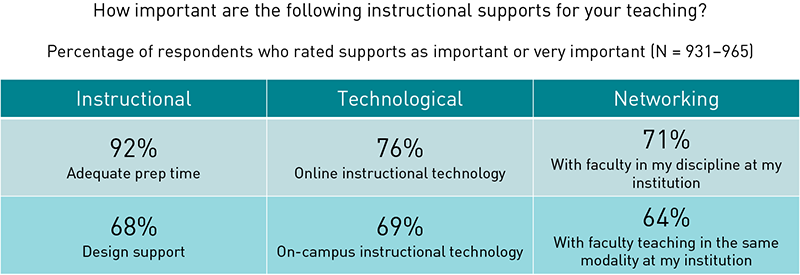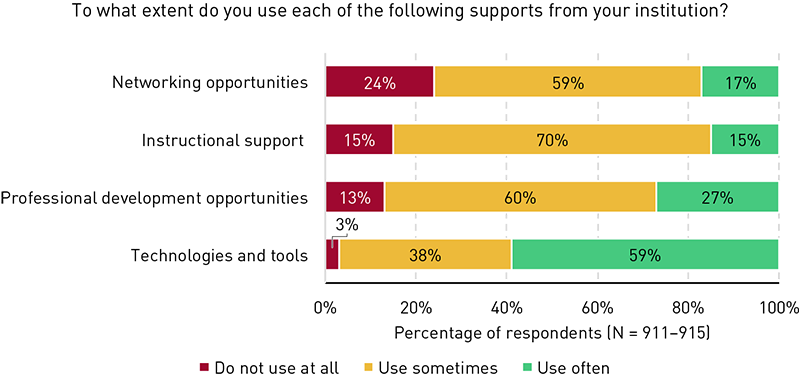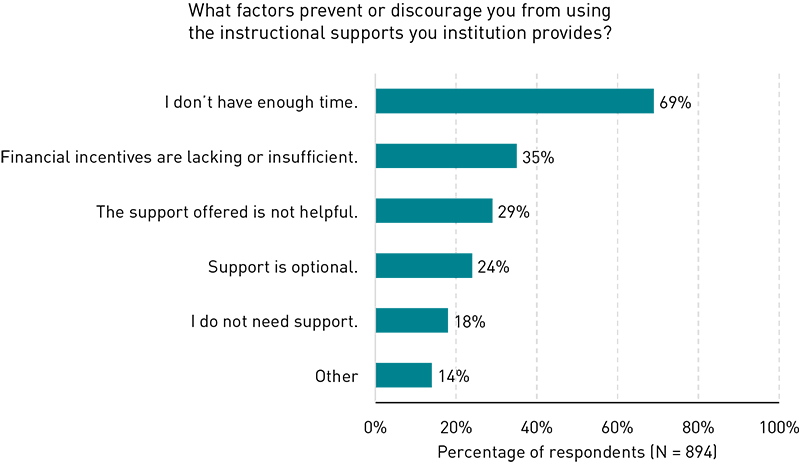Instructional Supports
Prep time and instructional technology are the most important supports for teaching. Faculty rated the importance of a number of instructional supports offered by their institutions. The types of support fell into four main areas:
- Instructional support: Instructional design, teaching assistants, prep time, policy supporting flexibility in modality, help using personal and instructional technology
- Technology and tools: On-site instructional technology (e.g., AV), online instructional technology (e.g., videoconferencing), AI, adaptive learning tools, and analytics tools, and extended reality
- Networking opportunities: Networking with faculty in the same discipline and outside of their discipline
- Professional development opportunities: On-site instructional technology, online instructional technology, AI and adaptive learning tools, extended reality, learning management systems, learning analytics, assessment and learning design, accessibility and accommodations, and inclusivity and student belonging
Figure 16 presents the top two instructional, technology, and networking supports that faculty identified as being either "important" or "very important." The number one instructional support identified as being important was adequate prep time—92% of faculty rated this as being important. Design support (68%) was the second most important instructional support. The two most important technologies were online (76%) and on-campus (69%) instructional technologies. The two most important networking opportunities were with faculty in the same discipline at the same institution (71%) and with faculty teaching in the same modality at their institution (64%). Finally, the top three most important professional development topics were inclusivity and student belonging (82%), accessibility and accommodations (76%), and assessment and learning design (72%) (see figure 17).


Support for instruction is important, but faculty don't have time to use it. We asked faculty how often they use instructional supports offered by their institution. A majority of faculty often use supports for technologies and tools (59%) (see figure 18). However, when it comes to instructional support and opportunities for networking and professional development, faculty don't use these often. We explored potential factors that prevent or discourage faculty from using instructional supports and found that the most common reason was a lack of time (69%) (see figure 19).


How are institutions supporting faculty teaching? We asked faculty to identify the most helpful thing that their institution does to support their teaching. Many of their open-ended responses touched on the support areas covered above. These included:
- Provides technology, tools, and space needed for teaching and learning
- Provides instructional support (e.g., access to a center for teaching and learning and instructional specialists/individuals dedicated to supporting faculty)
- Provides technology support (e.g., timely and effective support from IT)
- Provides training and professional development opportunities (e.g., opportunities to earn credentials and participate in workshops, tutorials, and other training)
- Provides opportunities for networking and collaboration (e.g., opportunities to for faculty-to-faculty sharing such as designated meetings to discuss faculty teaching issues)
- Provides autonomy and flexibility for faculty in their teaching
- Creates a culture that protects academic freedom